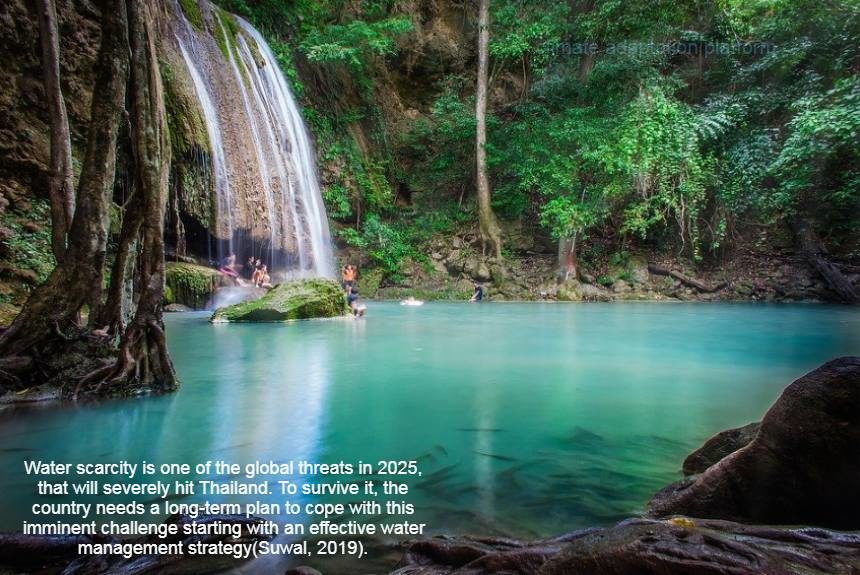Due to the drought disaster affecting many provinces in Thailand, which is more severe than last year’s, the government has established a water crisis centre.
The centre will be a temporary special command centre until the situation improves. This will be operated by the Office of the National Water Resources (ONWR) and “will oversee operations, situational forecasts, management, crisis warnings, and public relations’ (Sangiam, 2020).
The ONWR is working to comply with the 20-year national strategy to provide clean and sustainable water resources to people and industries, prevent flooding damages, and ensure a balance of water resource use and public cooperation (Sangiam, 2020).
Thailand and the effects of changing climate patterns
Sahisna Suwal, who wrote “Water in Crisis – Thailand” on “The Water Project” website, mentions:
- The Kingdom of Thailand is in Southeast Asia. Its population is over 68 million and spread over 513,115 square kilometres of land area. Thailand has 25 river basins and an annual rainfall of 1700mm. Its primary source of drinking water is surface and groundwater. Like many Asian countries, Thailand is continually threatened by industrial waste contamination and the impact of agricultural and human activities.
- Increasing population and urbanisation also slowly degrade water quality and resources. One-third of its surface water is of poor quality. Their most significant source of groundwater is the Lower Central plain surrounding Bangkok, which is used to meet the region’s demand.
However, it is being over-extracted and exploited because there is no existing policy to control the amounts of water drawn from it in terms of sustainable yield levels. - The changing climate patterns in Thailand have led to irregular rainfall, which causes droughts. Thailand lacks large reservoirs for water storage and relies heavily on dams. However, increasing droughts have lowered the dams’ water levels, which in turn has impacted rice production.
Thailand is a major rice exporter, and its agricultural sector accounts for 70 per cent of its national water supply. Therefore, an insufficient water supply caused by droughts can also impact their economy. - Flooding is another problem facing the country. Many regions experiencing heavy rainfall can damage their agriculture and livestock (Suwal, 2019).
Water scarcity is one of the global threats in 2025 that will severely hit Thailand. To survive, the country needs a long-term plan to cope with this imminent challenge, starting with an effective water management strategy (Suwal, 2019).
What the Thai government is doing
Bangrapa (7 January 2020) says that Thailand’s cabinet is set to approve 3 billion baht, equivalent to US$96 million, in funding to combat water shortages in Thailand, especially in vulnerable areas, as announced by the Office of National Water Resources (ONWR).
ONWR secretary-general Somkiat Prajamwong said the funding is from the central budget and will be used to implement 2,041 short-term relief projects to alleviate the worst effects of droughts from May to June. The projects include digging artesian wells, which will be done by four government agencies, including the Armed Forces Development Command (Bangprapa, 2020).
Deputy Prime Minister Prawit Wongsuwon stated that authorities plan to drill more than 500 artesian wells this year and noted that adequate measures are being taken to ensure water supplies remain available until July (Bangprapa, 2020).
Additionally, when the 2020 fiscal budget is passed, state agencies must disburse funds worth 9.4 billion baht or approximately US$300 million to implement 1,435 water projects in 54 provinces as soon as possible. The outcome of these projects will be to store 135 million cubic meters of additional water, which will be done before the rainy season, says Mr Somkiat.
Bangrapa (7 January 2020) states that, however, not every inch of Thailand will have access to this water due to geographical locations. Prime Minister Prayut Chan-o-cha urged residents to build small ponds to retain water for consumption during the dry season, the report says.
Sources:
Sangiam, T. (2020, January 6). Gov’t sets up water crisis center. National News Bureau of Thailand. Retrieved from http://thainews.prd.go.th/en/news/detail/TCATG200106152958284
Suwal, S. (2019). Water in Crisis – Thailand. The Water Project. Retrieved from https://thewaterproject.org/water-crisis/water-in-crisis-thailand
Bangrapa, M. (2020 January 7). B3bn fund to combat water crisis. Bangkok Post. Retrieved from https://www.bangkokpost.com/thailand/general/1829934/b3bn-fund-to-combat-water-crisis



Leave a Reply